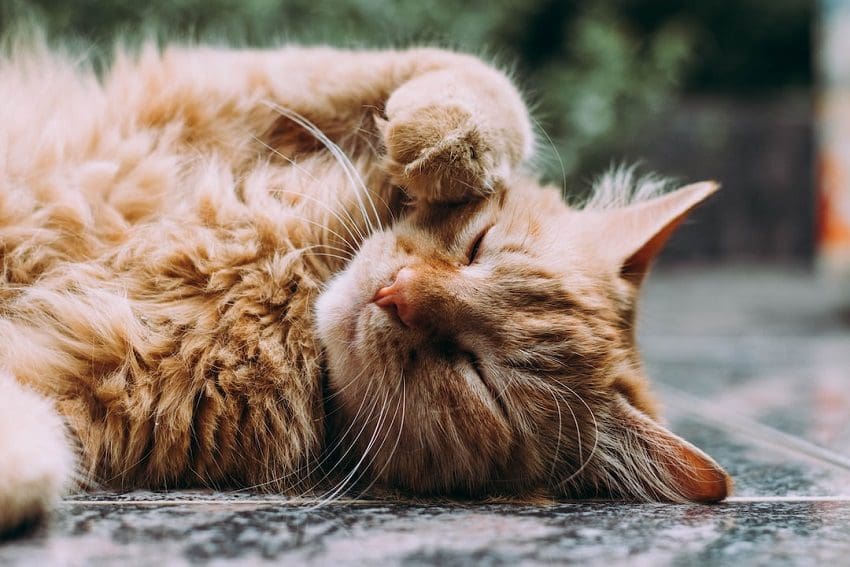Last Updated: 2 months ago
Cat owners know that fleas can be a real nuisance. Not only are they itchy and uncomfortable for your pet, but they can also spread disease and cause an infestation in your home.
Learning how to get rid of cat fleas is important to provide comfort for you and your cat.
The good news is that there are steps you can take to get rid of cat fleas and prevent future infestations. Keep reading if you want to learn how to get rid of cat fleas!
What Attracts Cat Fleas

Cat fleas are attracted to warm-blooded animals, including cats, dogs, and humans.
These parasites are usually found in areas with high humidity, such as the southeastern United States.
Fleas are able to jump from animal to animal and can also hitch a ride on your clothing.
The best way to prevent fleas is to keep your pet clean and well-groomed. Regular baths and brushing will help to remove any fleas that may be on your pet’s fur.
You should also vacuum your home regularly and wash your pet’s bedding in hot water.
If you live in an area where fleas are a problem, you may want to consider using flea collars or spot-on treatment.
Home Remedies for Cat Fleas
As a cat parent, it’s important to be aware of the dangers that fleas pose to your cat.
Not only can fleas make your cat uncomfortable, but they can also transmit diseases and cause anemia.
Fortunately, there are a number of home remedies that can help you get rid of fleas on your cat quickly and safely.
1. Give Your Cat a Bath
One of the most effective home remedies for getting rid of fleas on your cat is to give them a bath.
Be sure to use a mild shampoo and avoid getting any water in their ears.
You may also want to consider using flea combs to remove any fleas that are still on your cat’s fur.
2. Make a Flea Trap Using Dish Soap
Another home remedy for how to get rid of cat fleas is to make a flea trap.
A flea trap is simply a dish of soapy water that fleas will be attracted to. When they jump in, the dish detergent will coat their bodies and cause them to drown.
To make a flea trap using dish soap, you will need:
- A bowl or dish
- Dish soap
- Water
Directions
To make the trap, simply mix dish soap and water in a bowl or dish. The ratio of soap to water doesn’t need to be exact, but you want enough soap to create a good amount of suds.
Place the dish in an area where your cat spends time, such as near their food or water bowl or in their favorite sleeping spot.
The soap in the water will attract fleas, who will jump in and then be unable to escape. The dish soap will coat their bodies and cause them to drown.
You will need to empty the dish and clean it out regularly, as the fleas will continue to jump in even after they’re dead.
A flea trap can be a helpful tool in your battle against fleas, but it’s not a cure-all.
You will still need to take other measures to get rid of fleas, such as using a flea shampoo or spray on your cat and vacuuming regularly.
But a flea trap can help reduce the number of fleas in your home and make life more comfortable for your cat.
3. Use Essential Oils
Essential oils can be a solution for getting rid of cat fleas naturally. Some essential oils that are effective against fleas are eucalyptus, lavender, lemon, and peppermint.
You can either add a few drops of these oils to your cat’s shampoo or make flea collars by adding a few drops of oil to a bandana or piece of cloth.
Make sure to only use a small amount of oil, as too much can be harmful to your cat.
You should also do a patch test on your cat before using any essential oils to make sure they are not allergic.
Treat Your Cat With an Anti-Flea Products
Fleas can cause skin irritation, allergies, and even tapeworms if left untreated.
Fortunately, there are products available to help get rid of these pesky parasites.
When choosing an anti-flea product for your pet, it’s important to consult with your veterinarian first.
Your vet will be able to recommend the best product based on the type of flea infestation in your area as well as any underlying health issues that may affect how the product works for your pet.
Once you have chosen a product, make sure to follow all instructions carefully when applying it.
Most topical treatments require monthly applications; however, some products only need to be applied every three months or so, depending on the severity of the infestation in your area.
It is also important to remember that many anti-flea products are toxic if ingested by humans or other animals, so keep them out of reach of children and pets alike!
Call A Professional
If you find yourself struggling with persistent fleas despite using an anti-flea product, then consider calling a professional pest control company that specializes in treating fleas in cats and kittens.
They will be able to provide more targeted solutions, such as fogging or spraying, which can help eradicate any remaining fleas quickly and effectively without putting anyone at risk of exposure to harmful chemicals found in over-the-counter treatments.
No matter what solution you choose for getting rid of cat fleas, always make sure that safety comes first!
With proper care and attention given to selecting the right treatment option for both you and your furry friend, those pesky pests won’t stand a chance!
Apply Insecticide in Your Home to Kill Fleas
Insecticides come in many forms, from sprays to powders.
When choosing the right product for your needs, make sure it specifically states that it kills fleas on the label.
Once you have chosen an appropriate insecticide, follow the instructions carefully when applying it around your home.
Be sure to treat all areas where fleas might be present, such as carpets, furniture, and pet bedding; this will help ensure that all stages of the flea life cycle are eliminated so they don’t return later on down the line!
It’s important to note that while insecticides can kill adult fleas quickly and effectively, they may not always work against flea eggs or flea larvae already present in your home environment, which means more treatments may be necessary over time if new infestations occur.
Keep pets away from treated areas until dry; this will help prevent any potential health risks associated with exposure to chemicals found in insecticides.
Using an appropriate insecticide is one of the most effective ways of getting rid of those pesky little critters once and for all!
So if you’re dealing with a flea infestation at home, remember to apply insecticide safely according to the directions given by the manufacturer and enjoy being free from those bothersome bugs!
Prevent Future Infestations by Reducing Potential Attractions
To prevent future infestations, you should take steps to reduce any potential attractions that may draw them into your home. One way to do this is by keeping pet food dishes clean at all times.
Any spilled food or water can attract fleas as they look for sources of nutrition.
Make sure to regularly vacuum carpets and furniture, too. This will help remove any existing fleas from these areas as well as flea eggs, which could hatch later on if left unchecked.
Flea eggs are not easily killed by insecticides, so you should take extra measures to vacuum and clean your house.
You should also consider using a flea collar or spray on your pets when going outside.
This will help keep them protected against possible infestations while outdoors, where they may come into contact with other animals who have been infected with fleas already.
Make sure to seal up any cracks or crevices around windows or doors where fleas might enter your home from outside sources, such as wild animals like mice or rats.
By taking these simple steps, you can greatly reduce the chances of having a future infestation in your home caused by fleas!
Conclusion
The best solution to getting rid of cat fleas is to take preventative measures.
Vacuum carpets and upholstery regularly, treat your pet with an anti-flea product, apply insecticide in your home, and reduce potential attractions for fleas.
Taking these steps will help you protect your cat from the discomfort of flea infestations and keep them healthy and happy.

Olfa knows how to get things done and has a keen business sense that others admire. She’s always on the go, coming up with new ideas! Her ability to anticipate the needs of her readers and deliver information that they want is what makes CatVills such a success. She loves cuddling her cat Picaciu. He is her inspiration.
